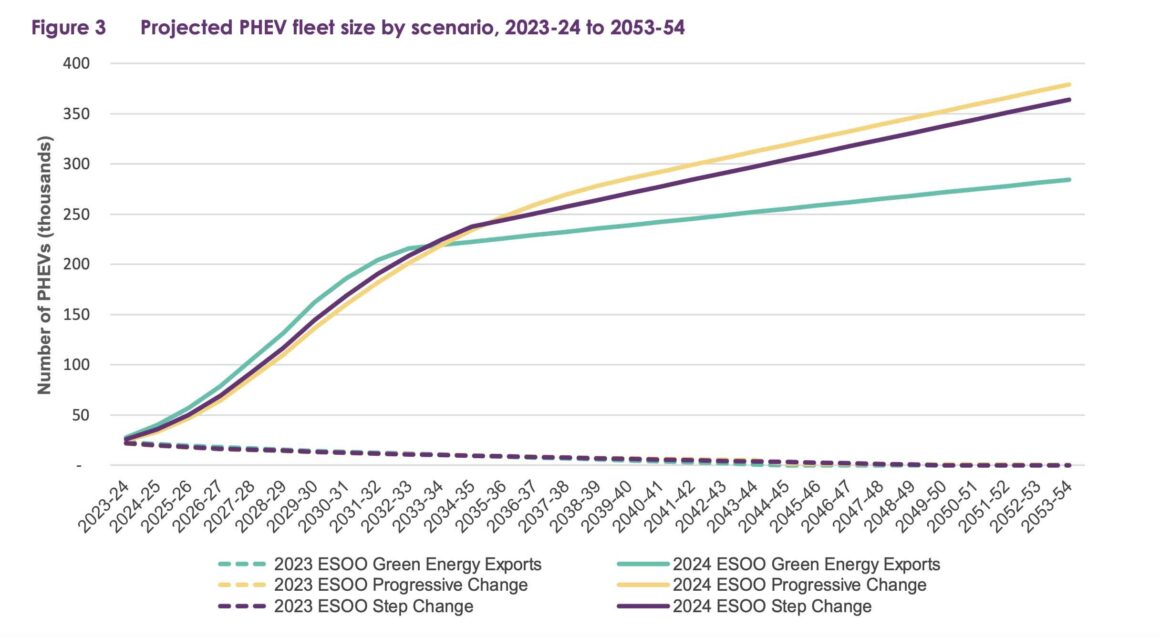Forecasts for the uptake of electric vehicles in Australia have been slashed dramatically – and the impact of the federal government’s signature vehicle emission standards, which allows car makers room to push hybrid options, have been blamed – to the delight of the big Japanese car makers.
The latest 10-year outlook by the Australian Energy Market Operator, which includes forecasts for consumption and supply over the coming decades, now predicts that there will be four million EVs on Australian roads by 2034, consuming around eight terawatt hours (TWh) a year from charging from the grid.
That four million forecast would account for around one quarter of all residential passenger vehicle, but it is down significantly from the forecast of seven million EVs made just last December.
AEMO says the EV forecast has been “tempered” by new data that reflects longer vehicle lifetimes – which means owners of petrol and diesel cars may be slow to buy new cars and make the switch to electric.
But it also cites the impact of the federal government’s New Vehicle Efficiency Standard (NVES), which was legislated in May 2024 and will take effect from January 1 next year.

It says NVERS will provide flexibility to the big manufacturers in how they reduce emissions, and it notes many of them will now choose to do so through mild hybrids and plug in hybrids, rather than full battery electric cars.
NVERS was contested heavily by the legacy car industry, and the federal Coalition and conservative media, and there was concern that the concessions made would slow the hoped-for transition to EVs. Japanese car makers, in particularly, fought furiously against the proposal, as they have in other countries.
Their efforts appear to have paid off. Perhaps the most stunning change in the AEMO forecasts is the revised outlook for plug in hybrids (PHEVs) – one of the favoured technologies of the legacy car makers because it does little to change their business model that is dependent on engine repairs, and does not do so much for cutting emissions.
AEMO says the previous forecasts were for a declining share of PHEVs, and declining overall numbers. But these have been dramatically revised, as per the table below, which predicts the number of PHEVs on the rad to grow to more than 350,000, with the biggest jump in the next decade, rather than a reduction in numbers.

“The change in forecast values reflect revised buying preference assumptions for some consumers, considering battery range anxiety, limited public charging infrastructure, and limited model availability for some purposes
such as towing heavy loads,” it says.
You could probably also blame another of other factors on this – the pubic scare campaign and misinformation about EVs, the abject failure of unreliable Tritium DC fast chargers in giving the public confidence about range anxiety, and the influence of the big Japanese car makers led by Toyota, Mazda and Honda.
The two electric only brands that operate in Australia – Tesla and Polestar – have quit the main car maker lobby, the Federal Chamber of Automotive Industries – but their sales have also been impacted in recent months.
Both have been affected by the increased competition from lower cost Chinese car makers, Tesla could also be hurt by the outrage caused by CEO Elon Musk with his comments on X, while Polestar only has one model on offer, the Polestar 2, although it is about to release the Polestar 3 on the Australian market.

The upshot of all this means that the so-called “saturation levels” of EVs in Australia – where it reaches 99 per cent of fleet share – have also been pushed back, by five years to 2055 rather than 2050.

Giles Parkinson is founder and editor of The Driven, and also edits and founded the Renew Economy and One Step Off The Grid web sites. He has been a journalist for nearly 40 years, is a former business and deputy editor of the Australian Financial Review, and owns a Tesla Model 3.

